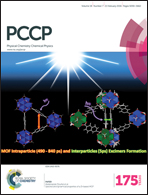Spontaneous polarization of solid CO on water ices and some astrophysical implications
Abstract
Reflection absorption infrared spectroscopy (RAIRS) is used to show that when 20 monolayer (ML) films of solid CO are laid down on solid water substrates at 20 to 24 K, the films polarize spontaneously. CO films were prepared on three types of water ice: porous amorphous solid water (CO-pASW), crystalline water (CO-CSW) and compact amorphous solid water (CO-cASW) with corresponding fields of 3.76 ± 0.15 × 107 V m−1 for CO-pASW, 2.87 ± 0.15 × 107 V m−1 for CO-CSW and 1.98 ± 0.15 × 107 V m−1 for CO-cASW. For comparison, CO laid down on SiO2 yields 3.8 ± 0.15 × 107 V m−1. Our results are of relevance to an understanding of the chemistry and physics of dense star-forming regions in the interstellar medium, in which dust particles become coated with solid CO on a layer of cASW. The polarization charge which accumulates on the CO surface acts as a catalyst for the removal of electrons and ions from the medium and may account for the low degree of ionization observed in these regions, a feature which is an important factor for the rate of star formation.


 Please wait while we load your content...
Please wait while we load your content...